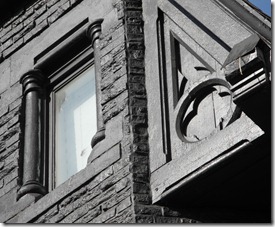The Paul Magder Fur Shop at 202 Spadina Avenue
During the final decades of the nineteenth century, the building at 202 Spadina was an impressive homes that faced out on a tree-lined Spadina Avenue. In those days, it’s postal address was #190 Spadina. Another house, #188, was attached to it on its south side. It was demolished decades ago. The home that is now 202 Spadina was built for the family of Charles Botsford, who owned a dry goods store located at 486-488 Queen Street West. His home is one of only two homes that remain from the days when Spadina was a prestigious residential street.
Houses on the east side of Spadina Avenue in 1906, looking north from below Dundas Street, when Spadina was a residential street. Photo from City of Toronto Archives.
In 1965, Paul Magder opened his fur business on the premises at 202 Spadina, and eventually constructed an addition across the front of the house. Mr. Magder became well known in Toronto for his fight against stores being forced to close on Sundays. He felt that the laws were unfair, and despite being heavily fined, he continued his struggle to have the laws changed to permit stores to be opened on Sundays. The laws were eventually changed, thanks is to the efforts of Mr. Magder.
Although windows have been altered, the upper portion of the house remain similar to its nineteenth-century appearance. The tall chimney and slate-rock tiles on the roof are still visible.
Details on the front of the house North side of the house
To view the Home Page for this blog: https://tayloronhistory.com/
To view previous posts about movie houses of Toronto—old and new
https://tayloronhistory.com/2013/10/09/links-to-toronto-old-movie-housestayloronhistory-com/
To view links to other posts placed on this blog about the history of Toronto and its heritage buildings:
https://tayloronhistory.com/2013/10/08/links-to-historic-architecture-of-torontotayloronhistory-com/
Recent publication entitled “Toronto’s Theatres and the Golden Age of the Silver Screen,” by the author of this blog. The publication explores 50 of Toronto’s old theatres and contains over 80 archival photographs of the facades, marquees and interiors of the theatres. It also relates anecdotes and stories from those who experienced these grand old movie houses.
To place an order for this book:
Theatres Included in the Book
Chapter One – The Early Years—Nickelodeons and the First Theatres in Toronto
Theatorium (Red Mill) Theatre—Toronto’s First Movie Experience and First Permanent Movie Theatre, Auditorium (Avenue, PIckford), Colonial Theatre (the Bay), thePhotodome, Revue Theatre, Picture Palace (Royal George), Big Nickel (National, Rio), Madison Theatre (Midtown, Capri, Eden, Bloor Cinema, Bloor Street Hot Docs), Theatre Without a Name (Pastime, Prince Edward, Fox)
Chapter Two – The Great Movie Palaces – The End of the Nickelodeons
Loew’s Yonge Street (Elgin/Winter Garden), Shea’s Hippodrome, The Allen (Tivoli), Pantages (Imperial, Imperial Six, Ed Mirvish), Loew’s Uptown
Chapter Three – Smaller Theatres in the pre-1920s and 1920s
Oakwood, Broadway, Carlton on Parliament Street, Victory on Yonge Street (Embassy, Astor, Showcase, Federal, New Yorker, Panasonic), Allan’s Danforth (Century, Titania, Music Hall), Parkdale, Alhambra (Baronet, Eve), St. Clair, Standard (Strand, Victory, Golden Harvest), Palace, Bedford (Park), Hudson (Mount Pleasant), Belsize (Crest, Regent), Runnymede
Chapter Four – Theatres During the 1930s, the Great Depression
Grant ,Hollywood, Oriole (Cinema, International Cinema), Eglinton, Casino, Radio City, Paramount, Scarboro, Paradise (Eve’s Paradise), State (Bloordale), Colony, Bellevue (Lux, Elektra, Lido), Kingsway, Pylon (Royal, Golden Princess), Metro
Chapter Five – Theatres in the 1940s – The Second World War and the Post-War Years
University, Odeon Fairlawn, Vaughan, Odeon Danforth, Glendale, Odeon Hyland, Nortown, Willow, Downtown, Odeon Carlton, Donlands, Biltmore, Odeon Humber, Town Cinema
Chapter Six – The 1950s Theatres
Savoy (Coronet), Westwood
Chapter Seven – Cineplex and Multi-screen Complexes
Cineplex Eaton Centre, Cineplex Odeon Varsity, Scotiabank Cineplex, Dundas Square Cineplex, The Bell Lightbox (TIFF)

![f1244_it0634[1] f1244_it0634[1]](https://tayloronhistory.com/wp-content/uploads/2012/08/f1244_it06341_thumb.jpg)





